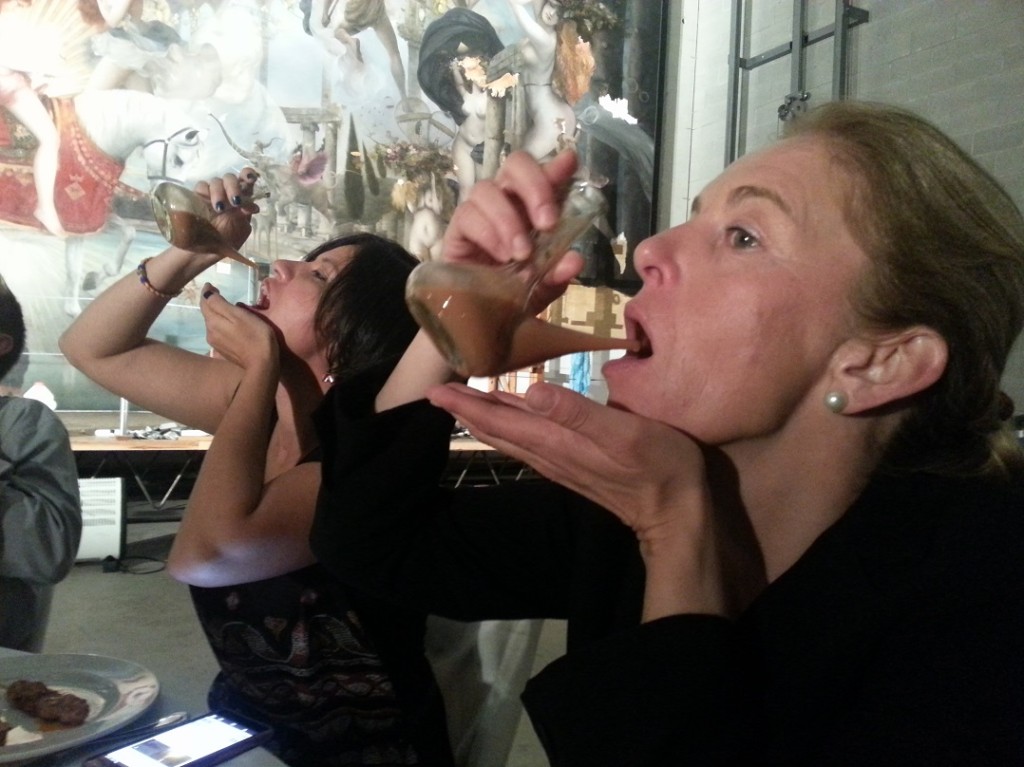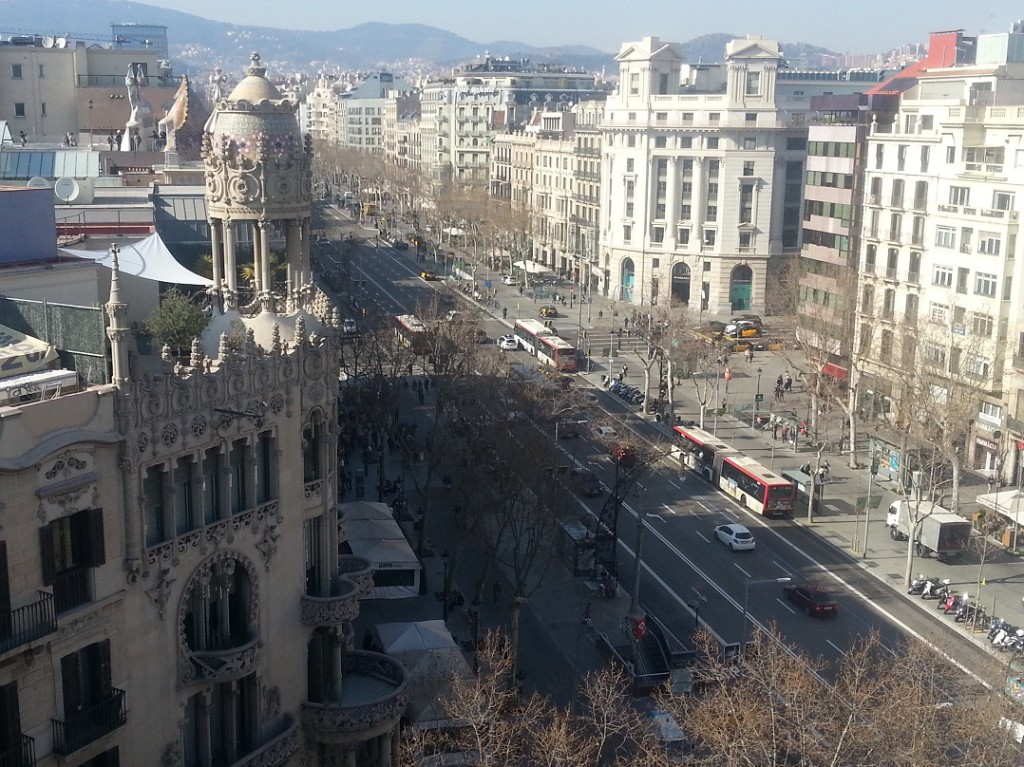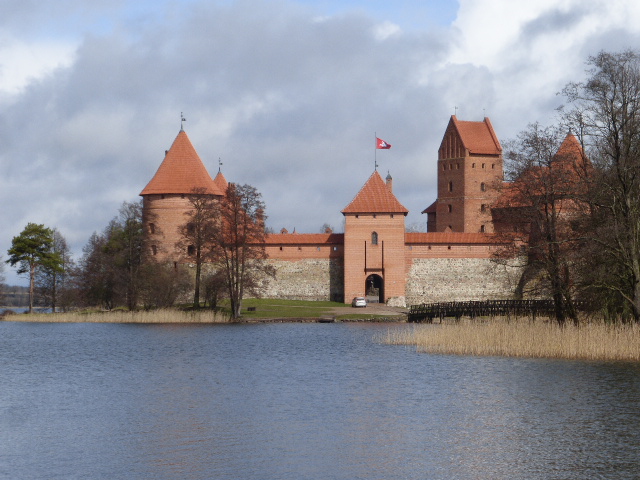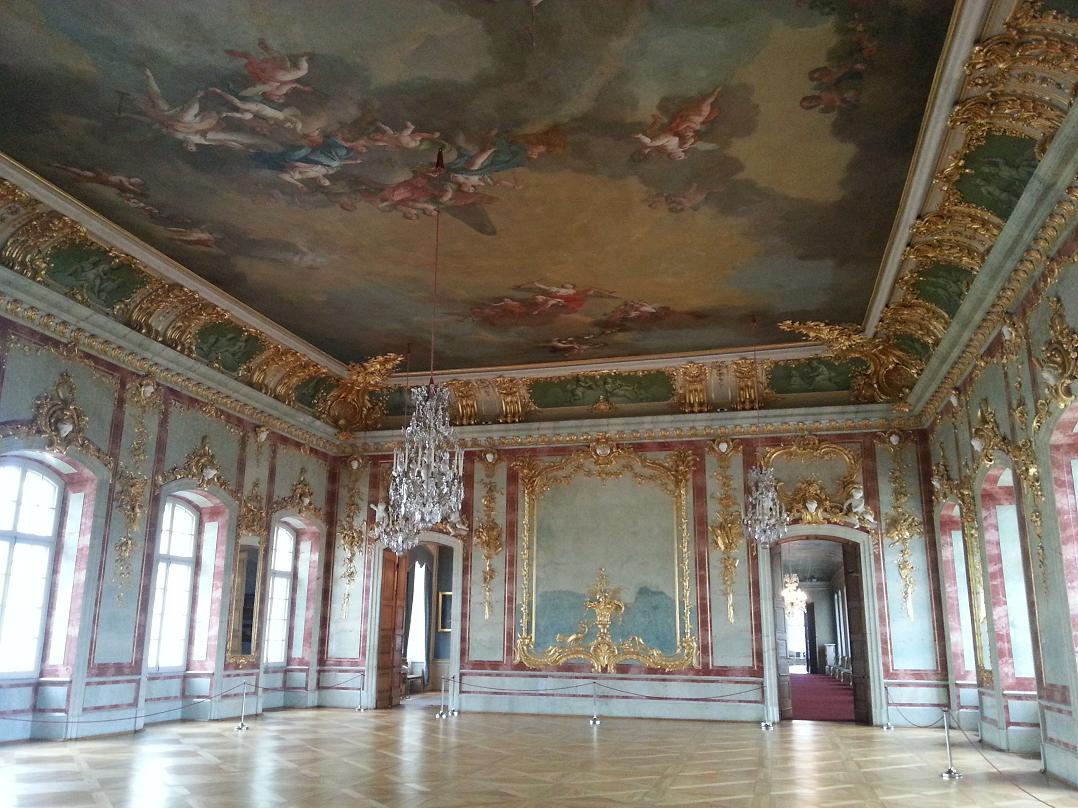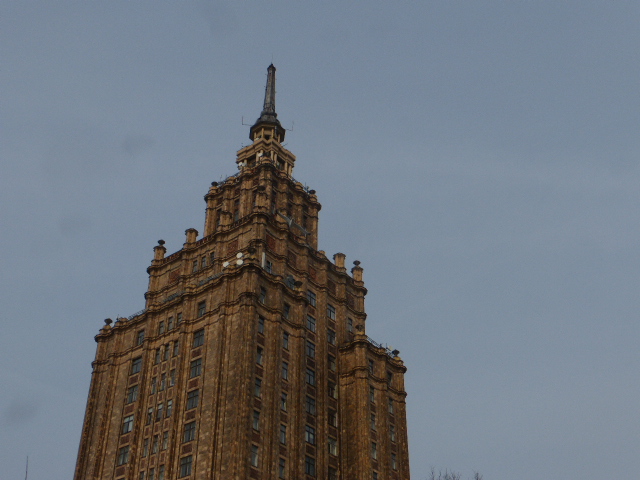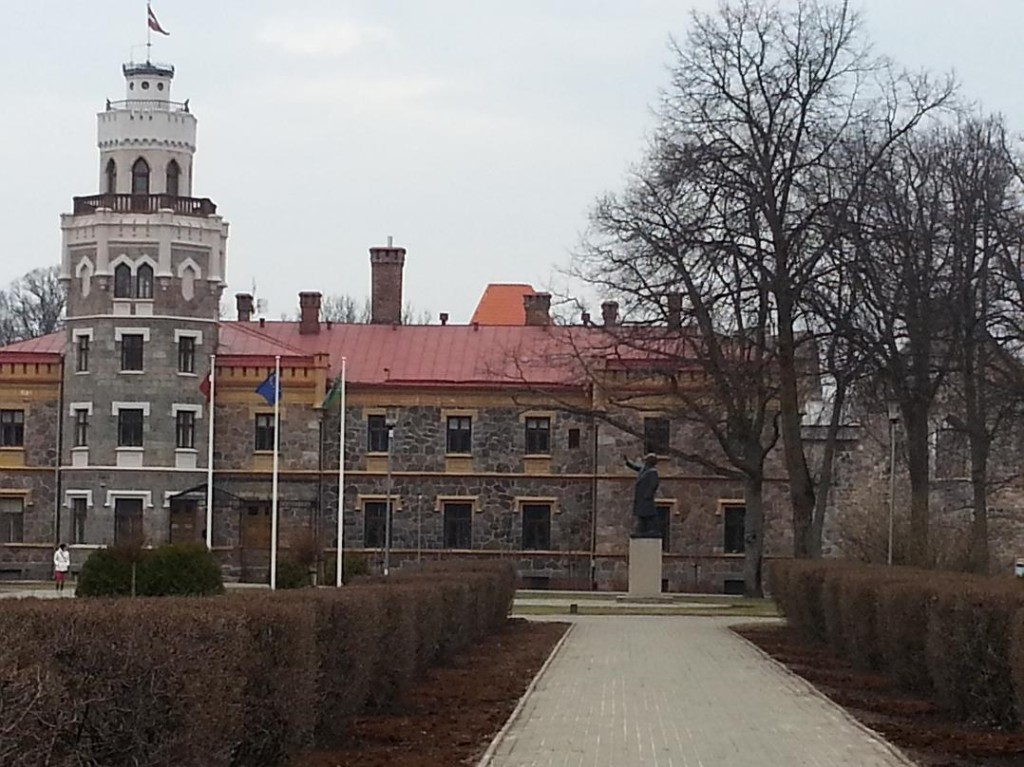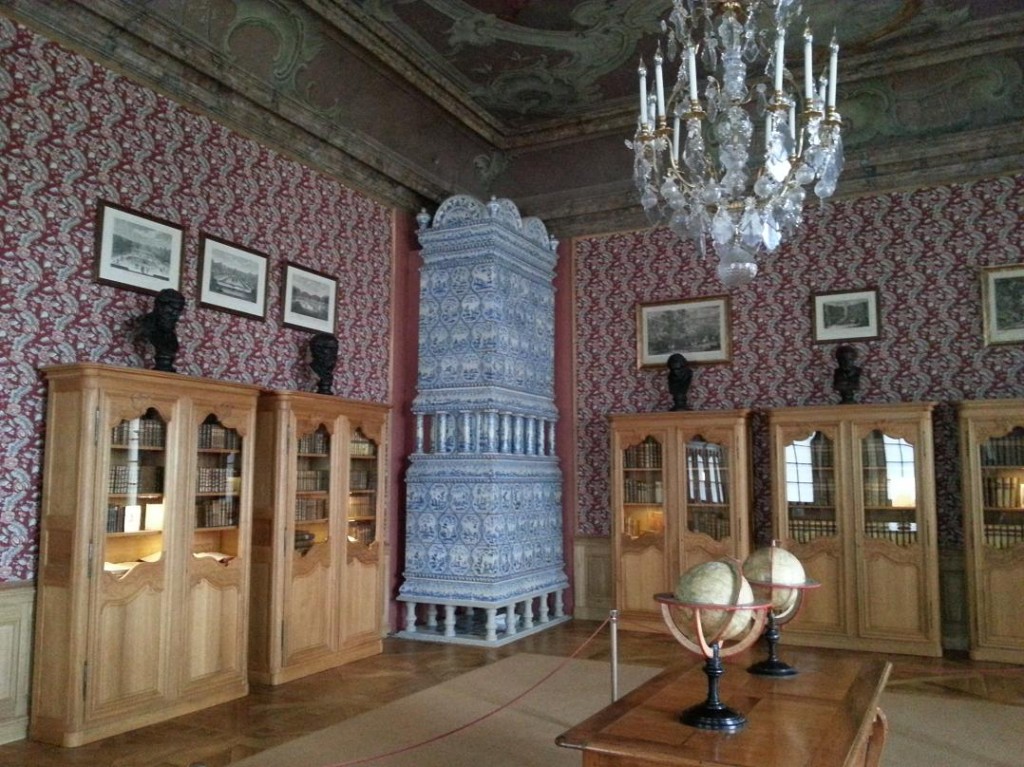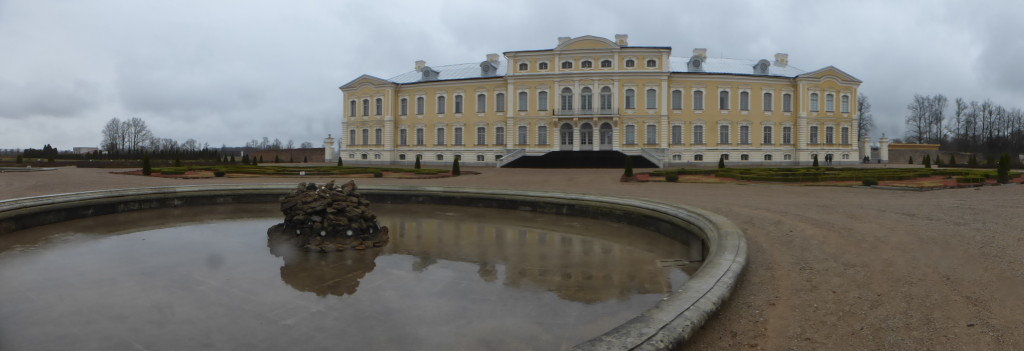
by Jane | Jun 2, 2015 | Europe |
An engineer turned artist;
an artist turned chef
We were driven to an industrial park on the outskirts of Banyoles for dinner. The itinerary told us that we would be attending a ‘pairing dinner’ with the strambotic painter Quim Hereu. In the golden evening sun we were warmly welcomed by Quim and his wife Tania and taken inside the industrial unit where a surreal world had been created. Follow this link to Quim’s website: hereu.net
The Stram Project

Jaume introduces Quim and his work
The large space was totally dominated by Quim’s latest work in progress – which is the second of a trilogy of works. The entire back wall was a work-in-progress – a MASSIVE painting with vibrant colours and wherever you looked you could spot something surreal or something simply beautiful. The first painting was already boxed up in readiness for its journey to Mexico where a buyer hopefully waits, the huge wooden crate stapled shut, although Quim would dearly love to see the painting exhibited in Girona.
Glassware and cutlery gleamed on a circular table in the centre of the room and the Argentinian chef Gonzalo Martinez who is based in Barcelona had set up a kitchen in one corner of the room and was studiously piping tiny little balls of foie gras onto plates. An old iron bed which had once belonged to Quim’s grandfather and a glasshouse glowing with light from a red chandelier were the only other decorations. Casually propped against one wall was the original drawing from which Quim was replicating his painting.

the table set for dinner
Quim was passionate about his subject and spoke vivaciously in Catalan whilst Juame Marin the Director of Marketing at the tourist board: Costa Brava Girona was translating just as fast. Forgive me if I am a little inaccurate but there was so much information to absorb. Strambotism is an artistic movement that was created and originated in Catalunya around 1974. At first glance it has similarities to surrealism but it is a totally separate entity. As I have already said, you could gaze forever at Quim’s work and always see something new.
After the introductions we all took our seats, joined by Jordi Xargay i Congost, the President of the Consell Comarcal del Pla de l’Estany and Ferran Vila Pugol who is one of the top sommeliers in the region. Gonzalo the chef had designed and produced each course to represent, compliment and explain a different aspect from some of Quim’s works, while Ferran the sommelier had paired a drink to compliment the food (and therefore also the paintings), even brewing or making some of them himself.

the centre piece of the painting
The first of the trilogy represents time, the birth of Venus and the craving to get eternal youth. I hope that Quim will forgive me if I don’t explain this correctly but the snail is key to the factory of time and also appears in the second painting which is about power. Not the power of swords, or strength or males, but it is more subtle. The centre figure of a lady on a horse is the first queen of Catalunya who had power over her subjects and even the Pope of the time. She holds a snail in her hand – and here is another link where the snail mirrors and represents time. Watch a snail and it moves frustratingly slowly. Move away for a short while and when you return it has gone. In the same way as time slips suddenly away from us and you are at the end of your life. Blink and you miss it. The third painting will represent freedom; because without freedom one can’t enjoy the other two concepts of time and power. The works represent six years of Quim’s life, with the majority of his time taken at the design stage with a blank canvas. These works are massive – 6metres by 12 metres, and the problem has been finding a buyer or a space large enough to exhibit them. As I mentioned before, Quim would dearly love Girona to display them, and preferably displayed together. He is so passionate about this that he is actually prepared to donate them for free, despite the amount of time that he has dedicated to painting them.
The food and drink

the chef Gonzalo at work
This pairing dinner formed a part of the ‘Live the History’ trip which Jaume and his team had arranged following the TBEX conference. Three other travel bloggers and myself had the most interesting of evenings. The four of us dined along with Jaume, Vikki who was our tour guide, and the other guests while Gonzalo kept extremely busy in his kitchen. You can see his website here: (www.gonzamartinez.com). We were in the company of true creatives and artists, passionate about their respective mediums and their region. Our first drink was a beer, brewed by Ferran with 3 different types of hops – and – this is the cool thing – the texture in the mouth was more important than the smell or the taste as it complimented the textures of the food and the art. By eating replicates of the snails and the clock we were consuming the representation of the snails/time and internalising it.
The flavours were sublime: Catalan style spinach, pinenuts, raisins Iberian ham, fois gras and a tiny cypress tree, together with a label – continued the theme of internalising the art and strambotism. Our second drink was a sparkling wine – again made by Ferran who had produced only 300 bottles and which balanced the saltiness of the chequerboard of the carpa of tuna and anchovies and raspberry caviar.

soup with a twist – in porons
Perhaps the pairing was most visual with the third dish. It was matched to a desert scene but one where the turbaned camel riders had porons instead of heads (a poron is a typical Spanish way of serving wine) – and now we had to drink the most exquisite soup from glass porons. The desert theme was continued with home made harissa and fish on skewers and paired with a very special white wine from the region. We kept the same shape wine glasses throughout our meal and Ferran explained that in his sommelier world the shape of the glass has no meaning at all. The drink is appreciated through smell and taste not by the shape of the glass. He also told us that this region of Catalunya is one of the chief producers of cork, and while the artificial bottle stops are fine for a young wine, an older wine should only be stoppered with cork. Our fourth course was a sweet sausage accompanied by a foamy mashed potato. But even the sausages were not simple. They each had a centre of the local herbal drink ratafia and had an outer casing first of a seaweed and then the finest, thinnest spring-roll pastry. The strong flavours of the sausage were balanced with a robust red wine from the south of Catalunya.
This fourth course was paired with the massive painting under which we were all seated and by now I was certainly appreciating the imagery and the connections. The strength of the horse, the meatiness of the sausage and the flavours of the red wine all connected and flowed through each other. The fifth course was about cats and the apple temple, and like the painting and the sparkling Muscat wine it had an altogether lighter feel to it.

work in progress
Quim talked about his influencers and how with the Catalan spirit and strambotism his creativity and techniques can fly. What makes Quim so amazing is that he initially studied as an engineer but he followed his passion and moved across into the art world.
A Michelin star lunch
The following day we took lunch at a Michelin star restaurant in Banyoles where the chef had moved from the art world into that of food and cooking.
Both Quim the artist and Pere the chef are true masters in their second choice of career and are at the top of the tree – which also proves that it is never too late to follow our dreams and our hearts and we should pursue that which makes us truly happy.
Ca l’Arpa is a Michelin star restaurant in Banyoles where we were privileged to a tasting lunch. The chef Pere Arpa is from the town and his restaurant and small boutique style hotel is in what was once his grandfather’s house. Decorated in muted greys and whites with just a few splashes of colour, one of the nice touches in the dining room were the huge plate glass windows which offered a view to the shiny stainless steel kitchens and the chefs working behind the scenes.

the window into the kitchen
Our wine was carefully chosen to compliment the meal and as was to be expected, everything was sourced and produced locally and from Catalunya. The first wine interestingly was aged in ceramic barrels as opposed to the traditional wood and from the Finca Olvidardots and made by a woman which is apparently also quite unusual in what is a predominately male dominated occupation here. The wine accompanied our starter of a ravioli of apples and black sausage (blood sausage and rice) – and then the food kept coming.
We had numerous, exquisite tastes and bursts of flavours, all presented on little platters or saucers and served to us either by Pere himself or his wife Montserrat, along with a detailed explanation of what we were eating or drinking and how the flavours had been designed and combined. One of the wines was a biodynamic wine and came in a plain bottle with no label – just a simple collar around the cork. This was produced by a Swiss owner at the cellar Bell Lloc near Palamos. Then followed an animated discussion around language and exactly what cut of meat we were eating when Pere presented it to our table before carving it. He said that it was veal – and the ultimate general consensus was the shank, but whatever, it just melted in the mouth and it was divine. Pere had not forgotten that one of our group was a vegetarian and he had devised separate dishes for her with just as much care and thought as those for the rest of us.

Pere Arpa explains his dish
Our menu included delights such as a fresh cheese and plums, a sweet and sour terrine of pig’s head with onions, marinaded sardines on a little bed of chickpea puree with sunflower seeds scattered over the top and green, white and purple asparagus. There was a sweet sausage of liver and curry butter (very subtle and delicate), a dessert of passion fruit and marscapone and a whole range of breads during the meal and a selection of little bonbons at the end.
After our lunch Pere showed us around the hotel upstairs and some of the bedrooms which have all been tastefully decorated and which overlook a serene little courtyard and garden at the back of the building. Pere changed the direction of his career at the age of 25 and for 20 years he has dedicated himself to cooking. He moved into his grandfather’s old home 8 years ago and extended and altered the house so that he could accommodate guests whilst cooking. The overall ambience is one of calmness and tranquility. There is a link to his previous life as an artist (with paint as he is still creating masterpieces albeit with food) as one of his paintings is displayed behind the reception desk.

Ca l’Arpa
The magic and passion of Catalunya
The unique experience of the pairing dinner hosted by Quim Hereu was a very different experience to our lunch at Cal l’Arpa, but the Catalan region was weaving its magic and encircling and entwining us, drawing us tighter with strands of an opaque smoky substance. Hard to see and not entirely tangible but there and ever present, the region has a culture and an identity, a passion and a pride which is expressed through its people and its food and its drink.
Engineer becomes artist, artist becomes chef. two men. Both creative, talented and passionate. Both proudly Catalan.
Quim produces his works in an industrial space; his initial career as an engineer stemmed from industry and Pere now lives and works in the space of his grandfather. Thanks to everybody involved from the tourist agencies of Pla de l’Estany, Pirineu de Girona, the Costa Brava and Catalunya who made these such amazing experiences. As usual, all opinions are my own and were not influenced in any way.

by Jane | Apr 26, 2015 | Europe |
Where am I off to next?
TBEX is the world’s largest gathering of travel bloggers, writers and new media content creators who will be meeting in Spain this week, and I am VERY excited to be a part of it.
The TBEX conference itself takes place in Lloret de Mar over two days, beginning with a welcome beach party, complete with food, drink and entertainment but there are events and press trips arranged across two weeks.
I get into Barcelona on Sunday and will stay at my hostel which is in the thick of the city. I will be taking part in two separate tours to see parts of Barcelona which are new to me, before heading up to Lloret on Thursday.

the view from my hostel rooftop terrace
In Lloret I was unable to reserve a room at one of the conference base hotels (or at least at a price that I could afford to pay) so I am staying in the town at a hotel with a pool and a gym and hopefully wonderful wifi as I will need to be doing an awful lot of work over the weekend.
Following the conference I will be heading south to Salou for a few days where I believe I have 4 nights free in a hotel (courtesy of links with TBEX) and where I can catch up on some R&R and much writing.
I am excited that I will be meeting lots of other travel bloggers – many whom I have been following avidly myself since before I was blogging, but I also will be pitching my plans for an online programme to members of the travel industry.
I have been busy putting together a digital e-course which I hope will encourage people to grow their self confidence and self esteem via the the medium of travel. Whilst is is still in the draft stage (thank you to my little band of testers) I am bursting with ideas and enthusiasm for it.
So follow me and learn what goes on at a travel blogger convention (I am quite in the dark at this stage myself) and see how my ideas for my new concept are received.
I could also mention here that I am pleased to be flying to once again with Norwegian Air – my new best airline – who have again have come in the cheapest for my dates and destination (future discounts and free flights gratefully received)

by Jane | Apr 24, 2015 | Europe, Lithuania |
I left Riga on my own, taking the four hour bus ride across the border and into Lithuania. I arrived at the bus station and after tramping around for half an hour I finally found my hostel. I was hot, bothered and thirsty but with every step I was thanking my lucky stars for my new Osprey backpack which is so well balanced that it was (almost) a dream to carry.
The hostel was just one side street off the main town triangle so I dumped my bag and I went straight out for food and a bit of a wander.

pretty pastel church in the late afternoon sun
Following the recommendations of the hostel owner I found a lovely little place, with floorboards, long wooden bench tables and over 20 artisan beers. They did VERY cheap Lithuanian food too and after opting for an extremely pink soup and a dumpling stuffed with meat I began to feel a bit more human again.
And then as the afternoon sun turned the buildings a soft warm gold I walked around the old town on a whistle stop tour to get my bearings before heading back to the hostel for an early-ish night. It was lucky that I did get to sleep early because at four in the morning a group of young American students arrived back from a bar crawl and proceeded to have a loud conversation in the middle of the dorm. If you follow me on Facebook you will be more than aware of my displeasure at this, but after nearly two years of sleeping in large dorms, it thankfully happens very rarely.

The Ministry of Defence Building
After a lovely free breakfast of waffles and jam I decided to join a free walking tour of Vilnius. A very large group was led stoically by Raminta who somehow managed not to lose any of us in the drizzle and she pointed out tons of things of interest on our tour. She led us into lots of the little courtyards that Vilnius is famous for and at the end she recommended a place for lunch and joined us so that she could continue to chat to us.

I always hunt down a free walking tour
Recommending traditional Lithuanian food she arranged to send those of us who were interested additional information via email about some films that we had discussed on the tour and she also included a clip of the mayor of the town who, to demonstrate the the negatives of obstructing the highway, drove a tank over a car (I believe it was his own car) which was illegally parked! As I have mentioned before in my previous articles about the Baltic countries, you have to admire the way that people simply go out and get things done.

Cathedral Square and the bell tower
After lunch, I tagged along with a group of Dutch students to visit the bell tower and later we all had a coffee together. As well as intelligent, fun company I got a student priced admission ticket by just being with them – a discount is always a bonus. The stairs inside the bell tower were quite hairy – open and wooden but they were nothing to the fright we all got when the bells suddenly rang out alongside us on the quarter hour. Once the bells had stopped it was incredibly peaceful looking down on the town and over at the castle and the three crosses on the hill.

view from the bell tower
Vilnius is stuffed full of churches, many painted in pretty pastel colours, whole others are derelict and falling down. The Palace is grand as are the University buildings and outside the Parliament Building anti-tank barricades have been left as a memorial and a reminder of the time when the country were fighting for their independence yet again.

Memorial barricades
There is a very interesting district in Vilnius old town which has declared itself to be an independent republic. Home originally to artisans and free thinkers it now attracts many who want to live by different rules. Street signs on the bridges into Uzupis proclaim that it is necessary to smile at all times and a wall has the constitution written up on glass mirrors in many languages; which includes such gems as ‘Everyone has the right to die, but it is not a duty‘ or ‘Everyone is responsible for his freedom’. You can find the constitution written in full at the end of this article. It is worth read.

The constitution wall at Uzupi
The following day happened to be April 1st – the National Day of Uzupis when the water from the fountain in the square would dispense free beer instead of water (it did) and you could get your passport stamped on entry (I was too early for this). They have their own flag (actually four, one for each season) and some hilarious street art and decorations including a statue of Jesus as a backpacker.

Thou shalt always be smiling
After two nights at my hostel with the noisy American girls and the free waffle breakfast I had to change rooms as they had advance bookings and no room for me. I never mind the actual changing but getting the timing right is always a pain as check in and check out never match up so I am sort of in limbo for a while with my bags stashed somewhere hopefully safe. In the meantime S had arrived in town, having caught up with me in his van. It was lovely to hear from him so we met up for a drink and agreed to drive on together into Poland two days later after he had visited the dentist for some work.

a popular bar snack – garlic fried bread and sour cream dip
On my final day in Vilnius I caught a bus and went to the castle on an island at Trakai. S had planned to come with me, but he was still being dogged by bad luck – he was kept awake for most of the night by a Romanian gang who were operating out of his hotel and the police who were called to deal with them. The weather threw everything at me while I was at the castle. The sun would shine and then the sky would darken and flurries of snow would whirl down, there was a biting wind and then rain. The castle was good though, and it contained many interesting displays inside its renovated rooms.

The island castle at Trakai
Arriving back at the hostel I discovered that I didn’t have a room at all for the night so I had to go and find somewhere else to stay. I found a gem of a place – the Hostelgate -with a cute little winding staircase which led up to the kitchen, a massive common room with some very fun, interesting people (a bottle of red vodka always helps to oil the wheels of friendship), a TV with loads of films and a massive dorm. I wish that I had found out about it earlier but better late than never and I know where I will stay again when I return to Vilnius.

Trakai castle
I spent my final night in Lithuania drinking vodka with some Spaniards, a Swiss guy, a Norwegian and a Dane and a drop-dead gorgeous Brazilian lady who was living in Russia with her boyfriend and was on her three monthly visa run. And while talking about travellers, it was also at this hostel where I met an Australian couple who were travelling long term with their three daughters who were I guess all under the age of ten and were perfectly adapted to hostel living. It was a happy hostel.
The following day I checked out and walked over to meet S. After his dental appointment we climbed into his van and I drove us across Lithuania and over the border into Poland.
Continue down to continue reading the Uzupis constitution and tell me if you don’t smile

One of the seasonal Uzupi flags
Uzupis Constitution:
Everyone has the right to live by the River Vilnelė, while the River Vilnelė has the right to flow by everyone.
Everyone has the right to hot water, heating in winter and a tiled roof.
Everyone has the right to die, but it is not a duty.
Everyone has the right to make mistakes.
Everyone has the right to individuality.
Everyone has the right to love.
Everyone has the right to be not loved, but not necessarily.
Everyone has the right not to be distinguished and famous.
Everyone has the right to be idle.
Everyone has the right to love and take care of a cat.
Everyone has the right to look after a dog till one or the other dies.
A dog has the right to be a dog.
A cat is not obliged to love its master, but it must help him in difficult times.
Everyone has the right to sometimes be unaware of his duties.
Everyone has the right to be in doubt, but this is not a duty.
Everyone has the right to be happy.
Everyone has the right to be unhappy.
Everyone has the right to be silent.
Everyone has the right to have faith.
No one has the right to violence.
Everyone has the right to realize his negligibility and magnificence.
Everyone has the right to encroach upon eternity.
Everyone has the right to understand.
Everyone has the right to understand nothing.
Everyone has the right to be of various nationalities.
Everyone has the right to celebrate or not to celebrate his birthday.
Everyone shall remember his name.
Everyone may share what he possesses.
No-one can share what he does not possess.
Everyone has the right to have brothers, sisters and parents.
Everyone is capable of independence.
Everyone is responsible for his freedom.
Everyone has the right to cry.
Everyone has the right to be misunderstood.
No-one has the right to make another person guilty.
Everyone has the right to be personal.
Everyone has the right to have no rights.
Everyone has the right to not be afraid.
Do not defeat.
Do not fight back.
Do not surrender.

Jesus: traveller and backpacker extraordinaire

by Jane | Apr 17, 2015 | Destinations, Europe, Latvia |
We drove south across the border into Latvia and immediately things changed. To be fair, the grim, sleety weather didn’t help but the roads became more potholed as our ‘motorway’ hugged the steel grey Baltic Sea which we could see through the white trunks of the silver birch trees. We drove through little villages of wooden houses – blink and you would miss them – and we went straight to the capital of Riga, stopping on the outskirts in a MacBurger place so that we could use their free wifi and track down a hotel for a couple of nights.

crossing into Latvia
S drove MAGNIFICENTLY through the horrible, devious and extremely stressful one way system of Riga whilst I fast approached a meltdown as we went round and round, but we eventually ended up at a small hotel a fifteen minute tram ride from the city centre with some not so dodgy parking in a compound behind it for the van.
After a decent night’s sleep I wanted to do some sightseeing so leaving S in bed I jumped on a trolley bus which ran past the hotel and I went into the old town. First impressions are that the old town of Riga is bigger than the old town of Tallinn, but like Tallinn it is stuffed full of churches with ornate spires, castle towers and turrets and parks. As well as the old stuff (I think it is predominately baroque) there is a large art nouveau element to the architecture and everything is very pretty.

architecture in Riga
I poked around in the Museum of War which is housed in the Powder Tower and also in the National Museum of Latvia which took me a few attempts to track down as there is an unimpressive doorway besides what appears to be a high street bank. The first museum was ok, the second one didn’t have that much information in English so I got a bit bored. For lunch I ate at a small cafe which served traditional Russian dumplings – you choose what type and how many you want from the large pots of boiling water and you then weigh your bowl at the till. I walked some more around the Freedom Monument which was glinting in the sun and the old houses and buildings before taking my aching feet and the trolley bus back to the hotel.

The Powder Tower
Unfortunately the next day S was still not well, so to give him and myself some space I checked out with my backpack and I went and found a hostel right in the thick of the old town. As I checked in I met Nick and Frankie who told me about a free walking tour that they were about to go and investigate so I tagged along with them for what was a tour of Riga that was a little bit different.
The tour concentrated on things that were mainly outside the old town. We went to the huge food market which was made out of old zeppelin hangers and we saw the big squat Soviet designed building that is known as Stalin’s birthday cake. I learnt that beavers live in the river that flows through the city (hence why many of the parks trees are protected with iron fences), and that the mound of old stones which looks positively medieval was not a castle tower but rather a dump for the stones and soil when the ancient town walls were dismantled.

Stalin’s birthday cake
We saw the little wooden houses which still remain outside the old town walls. Most of them look quite ramshackle now, but it is a matter of pride for the residents that they are still there. The ancient town rules were that no stone buildings could be built outside the city walls so that if an advancing army approached, the wooden homes could quickly be burnt to the ground so as not to afford the enemy any advantage. The people got fed up of being displaced time and time again as their homes were burned but when modernisation took place and the government wanted to replace the houses with stone or brick buildings they stubbornly refused to allow their homes to be bulldozed and demolished yet again.
Back at the hostel I met Caitlin, a US citizen who currently lives in Germany with her husband and who loves to travel. After a meal out we decided to team up the following day and visit the Turaida Castle complex at the town of Sigulda. As we set off in damp drizzle I thought that I could remember where the railway station was but after 25 minutes we were still wandering around in the rain. It was hidden inside a shopping mall, although when we arrived back later that evening and exited through the main door we couldn’t believe how we had been unable to find anything so massive!

visiting Turaida castle
But after a train ride and a cramped minibus journey later we got to Turaida castle which is on the edge of the Gauja National Park. It was quite beautiful even in the drizzle and it must be simply spectacular in the summer when everything is green and the red brick towers rise out of the surrounding forest. We happily wandered around the museum and the grounds and then, after getting the minibus back to town we went for a walk to find the Sigulda castles (old and new) – although we succeeded in getting lost yet again.
We think that because we both usually travel solo we relaxed when out with each other and we took no individual responsibility for directions so instead of being aware of our surroundings we chatted away and subsequently continued to get lost. Coming across an Orthodox church in the middle of nowhere we asked a lady who was talking to her friend on the street how to find the castle. We obviously didn’t look too competent at understanding her directions in Latvian so she indicated that she would give us a lift in her car. Not wanted to look a gift horse in the mouth we piled in the back and she kindly drove us to our second castle of the day.

Sigulda new castle (the old one is tucked behind)
The next day we set out via two buses to Rundale Palace. Imagine Versailles near Paris and this was something like that, just on a much smaller scale. There were 40 or so rooms open to the public that had been renovated and decorated and which were quite beautiful. I have been in many manor houses and castles but I have never seen anything like the heating systems which are employed in this part of the world. In a corner of each room was a large ceramic tiled ‘box’. A furnace behind would burn wood and service 3 or 4 rooms via this forerunner of a modern day radiator as opposed to the large open fires which would burn logs or coal in houses and castles in the UK.

the old ceramic tiled ‘radiator’
The palace gardens were newly planted up and all ready for spring and very bare but we saw pictures of them when everything is blooming. I would love to retrace my whole journey in the summer months when everything must have quite a different feel with flowers and green grass and blue lakes.

Rundale Palace
Returning to the nearby town of Bausca we jumped off our bus and we went to visit yet another castle. Disappointingly not very much of this building was open during the winter but it was still good to wander around. Despite the fact that there were hardly any other tourists there were plenty of staff dotted about between the various rooms. They were hilariously quick to try to shepherd us through and back out, frantically gesturing that we should pass through doorways or go up stairs, and they got themselves into a real tizzy if we decided to double back on ourselves.

Bausca castle
You will be pleased to know that we didn’t disappoint after leaving the castle and this time we actually managed to mislay the entire town centre and the bus station (yes I know that nobody we asked spoke English but bus usually translates into any language). We finally found a bus trundling along the street which we jumped aboard and luckily it took us back to Riga.
We went out for a lovely meal that evening in a typical little Latvian restaurant where as well as a very tasty meal we sampled several shots, including a cranberry liqueur and the brain-blasting Riga Black Balsam. Caitlin had an early bus the next morning and she wanted an early night, but she reappeared in the hostel kitchen at about 11.30pm – dragged there by a matriarchal Russian lady who had just checked in to her dorm with her husband and child.

shot samples
Newly arrived from Paris and hungry, this lady was not going to leave Caitlin sleep and she ordered her to get out of her bed and to join them in the kitchen for cake and yogurt. I was working on my laptop but I got roped in too; the whole time the pair of us were talked at loudly by this domineering but kindly lady. Caitlin escaped and went to bed and then later it was my turn to be woken by an extremely loud drunken New Zealander who was attempting to clamber into his top bunk above me. Threatening him with sudden death if he dared to vomit on me in the night he then chose to climb back down and hold a conversation with me at the top of his voice for the next half an hour. Sleeping in dorms is certainly not for the faint hearted!
On my final day in Riga I went to buy a second hand netbook as mine was playing up again. Guided by the staff at the hostel I found Second-hand-electronic-street and in one of the little shops I found a cheap netbook. Getting it back to the hostel I was relieved to find that Anna on reception spoke both Latvian and Russian and could re-organise it for me (although it does still lapse out of English). The computer had very obviously been acquired by the shop by illicit means – the owner was still logged onto his Facebook page – but there was no way I was going back to confront or accuse the two hard faced looking men in the shop who had sold it to me of stealing it.

second-hand-electronic-street
I sat and chatted for ages in the hostel with Anna who spoke frankly about politics and I learned a lot about the ethic makeup of the population of Latvia. I also learned how despite being born in Lativa she is often made to feel that she doesn’t totally belong because Russian not Lativan is her mother tongue and she is sometimes viewed with suspicion or non-Latvian by others based on her ethnic heritage.
I have to confess to being pretty ignorant about the history of the Baltic countries prior to this trip. I clearly remember the recent events at the beginning of the 1990’s when they each won their independence from the USSR but I was totally in the dark about the horrors and the occupations that they had all suffered throughout history. They saw some of the worse atrocities during the Second World War when a massive percentage of their population were either killed, conscripted into one foreign army or another or later deported to Siberia. They were denied their religion and their language and while each country has a very clear identity and a pride in their independence and history, people will simply shrug if you mention the possibility of any future conflict, as is currently being mentioned in the press. They have seen it all before. They are resilient.

The Freedom Monument





